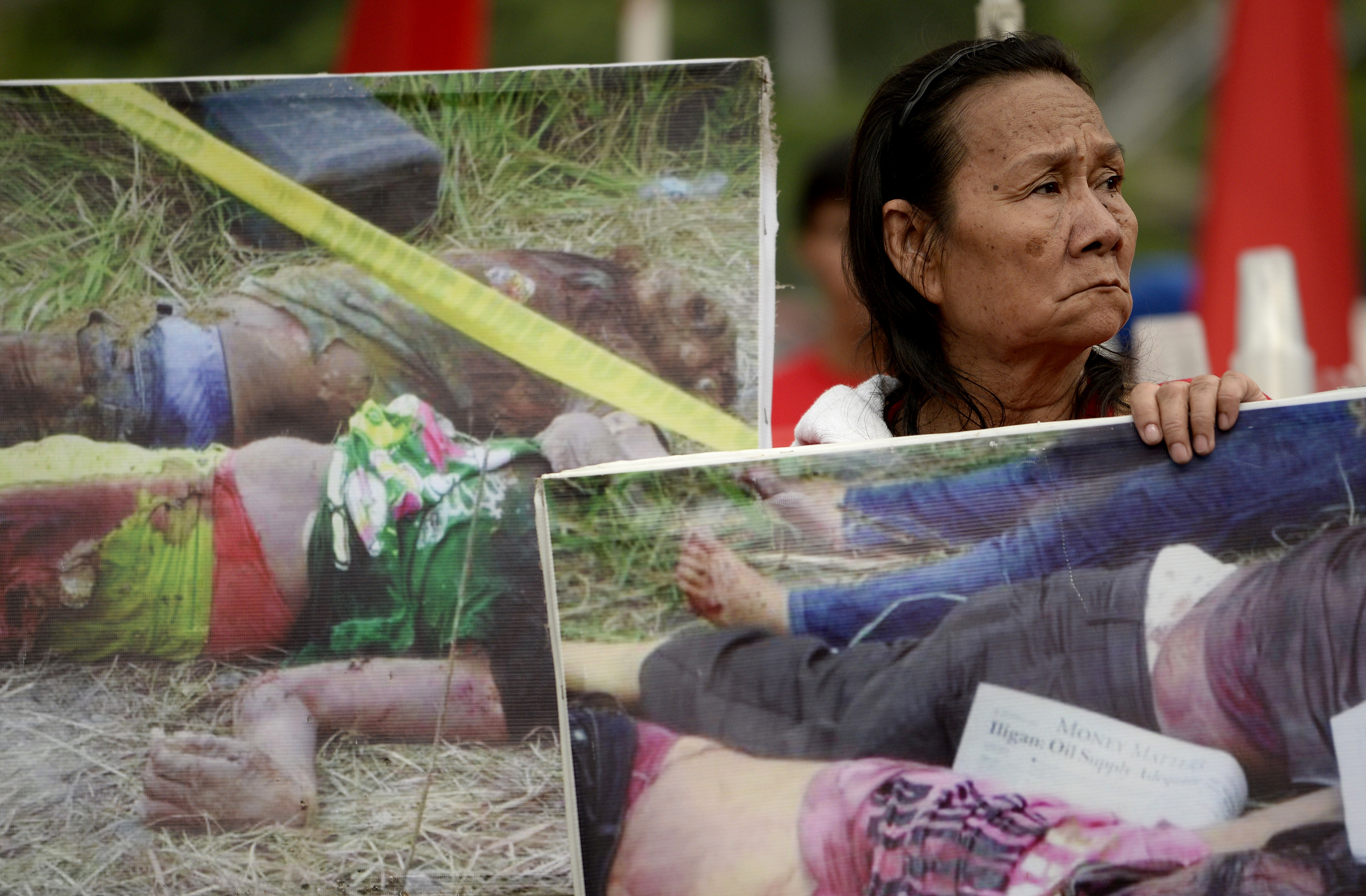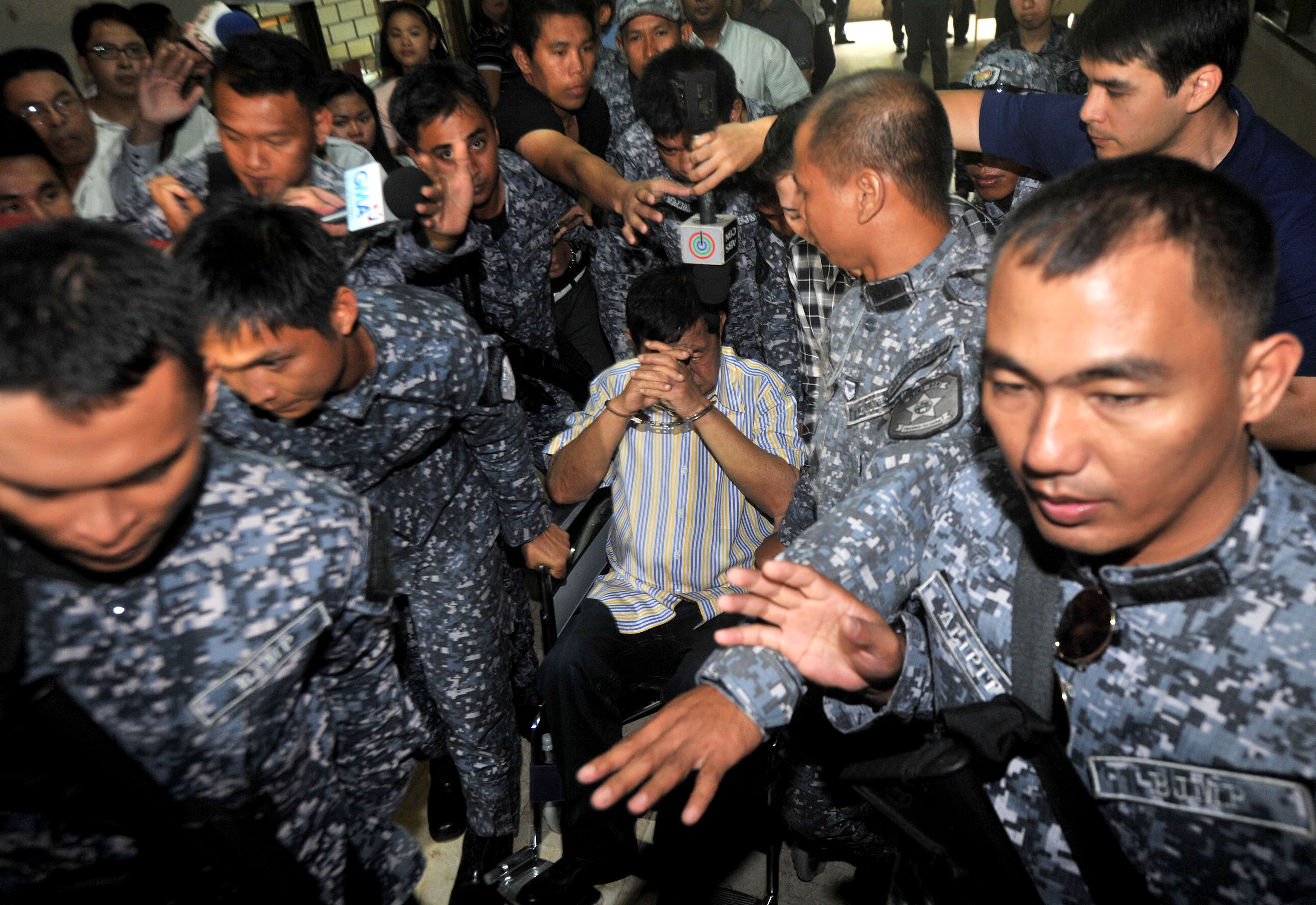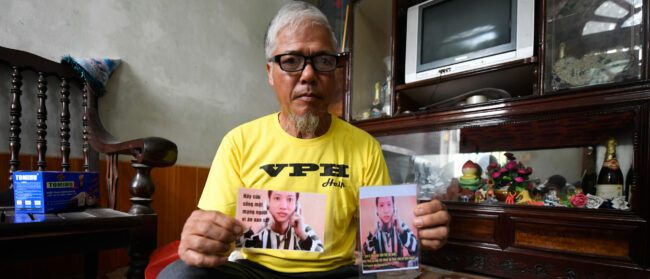“We used to say that, despite the number of media killings, we saw no official government policy to target the media, unlike the extrajudicial killings of activists and dissenters,” said Nonoy Espina, a veteran Filipino journalist.
Espina is the chairman of the National Union of Journalists of the Philippines (NUJP), a group that helped secure scholarships for the children of journalists killed in what is considered the single deadliest attack against members of the press anywhere in the world.
On 23 November 2009, 58 people, 32 of whom were journalists or members of the media, were killed in the southern province of Maguindanao. They fell prey to a deadly rivalry between the powerful political clan of the Ampatuans, the principal suspects in the massacre, and the Mangungudatus.
“What we saw [then] as the reason for the wanton violence against journalists was the system of governance in which the national centre of power depended on political clans … thus allowing the corrupt warlords and crime lords who parlayed their ill-gotten wealth into political power to flourish. This was the case with the Ampatuan clan of Maguindanao,” he said.
But now, as families of the victims still await justice on the 10th anniversary of the tragedy, Espina said journalists in the Philippines remain vulnerable to a culture of impunity as the administration of President Rodrigo Dutere targets them.
“Under Duterte, the media have officially become targets of [the] government’s counterinsurgency campaign. Not only have critical media groups and journalists been red-tagged, since September state security and civil government officials have openly accused media of being in cahoots with communist rebels,” he said.
Espina said the NUJP was called a terrorist group by Undersecretary Lorraine Badoy in an interview conducted on a Filipino news programme on 5 November this year, while Maj. Gen. Antonio Parlade, vice chief of staff for civil-military relations, said in an interview with Al Jazeera in October that the mainstream media were filled with “cadres” of the Communist Party of the Philippines.
Besides red-tagging, the government has also filed tax cases against Rappler, a news site critical of the administration, and threatened to reject the renewal of the franchise for broadcast network ABS-CBN after it failed to air Duterte’s campaign ad for the 2016 presidential elections.
Duterte himself has claimed, however, that his government will continue to respect the freedom of the press.
“Rest assured that the government will never waver in its duty to uphold press freedom, to promote free speech, cultivate a safer environment for journalists even as we work together in safeguarding our democratic institutions,” he said in September this year, as he swore in officers of the Malacañang Press Corps, the Presidential Photojournalists Association, and the Malacañang Cameramen Association.

Emily Lopez, who lost her cousin Arturo Betia in the Maguindanao massacre, said media killings continue to happen despite such pronouncements, however, with an additional 14 reported since Duterte came to power in 2016.
“They should be sincere in giving justice to the victims of the crime [the Maguindanao massacre]. But the killings among the ranks of journalists continue,” she said. “We are fighting for our case and now, after 10 years, we are fighting for others too.”
Politics, money, murder
Fighting for justice is a tenuous, emotionally-exhausting task, in which the odds are stacked against victims, especially when faced with powerful enemies and leaders who have a prickly relationship with the media.
Lopez would know, as well as Grace Morales, who lost her husband Rosell and sister Marites Cablitas to the Maguindanao massacre. Both were reporters for the newspaper News Focus.
They were part of the convoy which was stopped on its way to the town of Sharif Aguak – where Genalyn Mangungudatu was supposed to file the candidacy certificate of her husband, then Buluan vice mayor Esmael ‘Toto’ Mangungudatu, for the position of governor – and shot by some 100 armed men, killing 58.
The mass killings shocked the world and broke the hearts of the victims’ families.
Mangungudatu’s rival for the governor position, then Datu Unsay Mayor Andal Ampatuan Jr., was suspected of planning the attack along with his father, Andal Sr., and brothers Sajid and Zaldy, all of whom held political posts in Maguindanao and in what was then the Autonomous Region in Muslim Mindanao.
Lopez remembers climbing up a dump truck full of dead bodies to search for Betia, a reporter at the daily Periodico Ini. She did not find her cousin’s remains and had to scan morgues in the days after the killing.
“If the principal suspects at the very least are not convicted, that means impunity is very much alive in the Philippines”
Emily Lopez, cousin of Maguindanao massacre victim Arturo Betia
Morales, on the other hand, went through a grave state of denial. “I could not believe it. I thought it was just a bad dream. I wanted to wake up from it,” she said.
However, the two, along with the families of the rest of the victims, had to muster enough courage to file a case against the Ampatuans. And now, after 10 years, the regional trial court of Quezon City is expected to hand down its verdict on the case by 20 December this year.
The outcome of the case will have massive repercussions on journalist murders in the Philippines.
“If the principal suspects at the very least are not convicted, that means impunity is very much alive in the Philippines,” Lopez said.
It’s a possibility which they fear could happen because of the Ampatuans’ political connections. For one, Salvador Panelo, now presidential spokesman, used to be the clan’s lawyer.
Local news reports said Panelo met members of the Ampatuan family in August after Jehan-Jehan Lepail Ampatuan, wife of Saudi Ampatuan Jr. and Bai Soraida Biruaru-Ampatuan, his mother, wrote to the Office of the President and asked for a meeting. However, Panelo claimed he only told them that they should let Saudi surrender and nothing more.
Besides the Ampatuans’ ties with the powerful, money and further killings have also muddled the case. Lopez said some of the families have been offered hundreds of thousands of pesos to back out.
“In 2010, there were statements from some families [that] they were approached by certain people who offered them money. But someone who didn’t even finish his studies will not accept such kind of offer,” she said.
“There were others who said it may be worth considering because the case may not amount to anything. But I told them – ‘No! If we let this case go, what will happen to other incidents of killings? Why would we stop?’”
In 2018, Philippine news site Inquirer.net reported that the Ampatuans attempted to make money talk once again when five witnesses to the massacre were offered bribes. The victims’ lawyer, Nena Santos, was quoted in the article as saying the bribes ranged from P150,000 ($2945), to houses and even guns. Only one of them reportedly accepted the offer.
Some were even silenced through murder, with three prosecution witnesses slain. Esmael Enog, who said he drove the armed suspects to the site, was found mutilated in 2010; Alijol Ampatuan, a relative of the Ampatuans who supposedly became a state witness, was shot dead in 2012; and Suwaib Upham, a former member of the Ampatuan’s militia, was also shot in 2010.

Aside from guns and gold, what has made pursuing the case against the Ampatuan difficult is also apathy, both among the public and the government.
“Foremost, really, has been the general apathy of government. Beyond the lip service, there really has not been much by way of support for the families,” Espina said.
“In fact, [then-president] Noynoy Aquino could not bring himself to care enough to even get the numbers right. At a press conference with visiting US President Barack Obama, asked by an American journalist what his government was doing about media killings, he said 55 journalists were killed in Ampatuan. The correct number is 32.
“And except for a one-time handover of, if I am not mistaken, P10,000 [$197] to each family two or three days after the massacre, there has been no assistance whatsoever from the government. We contend that it is the state’s obligation to support the families since state agents – government officials and members of the security forces – were involved in their deaths.”
Despite this, the children of the victims are resolved to continue with the fight. They have their own way of reminding the government and the public of their struggle and the pains they went through.
“The families are determined. Lives have been stolen. The children of the victims themselves said let’s continue this,” Lopez said. “The children underwent a workshop for a play. Through the play, they were able to show to the people what happened in the Maguindanao massacre.”
Aside from the play, the orphans of the massacre also have their anthem – the songs written by Faye Morales, daughter of Grace and her late husband, Rosell. One of her songs is called “Justice”, while a new one she has written includes the lyrics: “This is our plea, for our stories to be etched in memory. Don’t ever forget the past.”
The play and Faye’s songs are their weapons against what is their worst enemy: being forgotten.
The public’s short memory, caused by temporary anger coupled with a long history of warlordism, is the reason why even as the orphans of the Maguindanao massacre have exploited all means to stay on the public’s radar, the suspects’ children, and even the suspects themselves, have still been successful in elections.
The Ampatuans enjoyed immense political clout in 2009 because of their ties with then President Gloria Macapagal Arroyo, who was their partymate in Lakas-Kampi-CMD. Even after the Ampatuan scions were removed from the political party, however, they continued to win posts in Maguindanao during the time of Arroyo’s successor Aquino, and eventually Duterte.
Andal Jr.’s son, Datu Andal “Datu Aguak” Santiago Ampatuan V, took his oath as mayor of Datu Unsay in July this year. Initially elected councillor, he eventually got the mayoral post after the vice-mayor and the mayor resigned.
Datu Sajid Islam Ampatuan, one of the principal suspects connected with the massacre, was also elected mayor in the town of Shariff Saydona Mustapha in Maguindanao this year.
While they remain in power, Morales, as well as orphans like her and their families, have to find other ways to support their studies as their scholarship funding has also been depleted.
Still, they will not give up.
Some of those who lost their parents in the tragedy are still barely in their teens, but they were forced to grow up and become aware of the slow and arduous wait for justice.
They continue the battle for legal retribution, with the lower court’s decision next month on the massacre a key date for all the families. But Grace said they know the fight for justice may not yet be over.
“If the court acquits the principal suspects, we will question it before a higher court. If they get convicted, they will question it also, maybe even up to the Supreme Court,” the 43-year-old widow said. “But we still have the young people. They will continue the fight.”


